Little Fixer-Upper
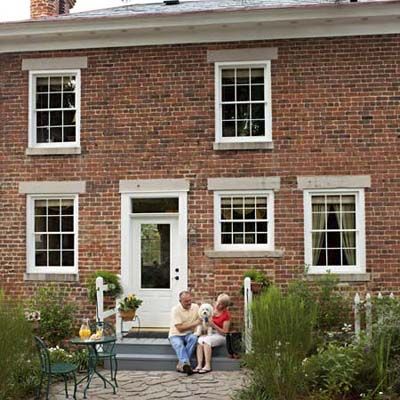
My husband, Walt, and I first laid eyes on the Petersburg, Virginia, cottage while visiting our son Greg and daughter-in-law Marion, who live 2 hours north. They had bought the adjacent, larger house as a vacation getaway—and potential retirement spot for Walt and me. In doing so, they’d also taken on this little fixer-upper that sat on the half-acre property—known as a “kitchen house,” it once served as the summer kitchen and servants’ quarters. With just four rooms, it seemed like it could be a cozy home for the two of us. Eventually.
So in May 2006, we moved into the main house. I’ll admit, it wasn’t an easy decision. I cried that first night and asked Walt if we were doing the right thing, leaving our friends and our country home in Pennsylvania’s Pocono mountains to take on this rundown little house in a slowly revitalizing urban area. But by the next morning, that moment of doubt had passed, and I was mentally picking out paint colors for what I was sure would be a three-month project.
Of course, four months in, it was still just a shell with no utilities.
Shown: Homeowners Walt and Roberta Purcell relax on their new back stoop, which faces the adacent Italiante house.
Before: Abandoned After a Fire
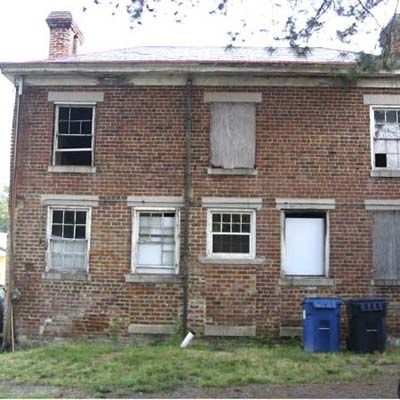
The house wasn’t much to look at, really. Abandoned for 20 years after a fire, the windows and doors were missing, charred, or boarded up. There were no floors downstairs, and the water-damaged plaster was crumbling. Squirrels ran in and out, and birds nested in the claw-foot tub. Yet there was a certain charm to the place. The old brick, dating from the 1850s, had wonderful color, the window lintels were solid granite, and the upstairs had heart-pine floors.
Opening Doors
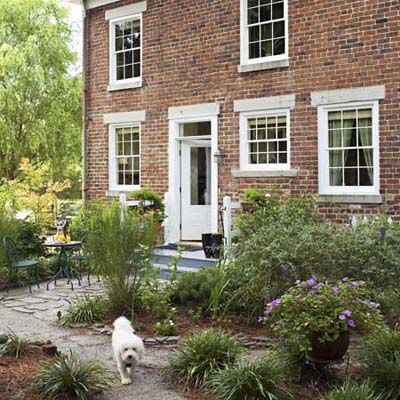
The back doorway, once bricked over, now leads to well-tended gardens.
After: Master Suite Miracle
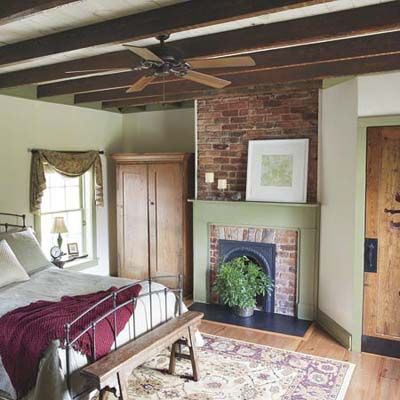
It turns out that a new home was just the kind of change—and challenge—Walt and I needed. The kids told us to consider both houses ours, but we decided to take on the smaller house exclusively, with its four original fireplaces, and beamed ceilings upstairs. With Walt’s background as a master plumber and all-around handyman, plus my passion for design, we figured we could make it livable. Soon after, we got to the insulation and drywall stage inside, and things really started to take shape. With only four rooms, we knew we didn’t have an inch to waste on mistakes, so we consulted with an architect.
Shown: Milk-painted pine planks fill the gaps between the newly exposed ceiling beams and complement the new pine floors.
Before: Bedroom Fireplace
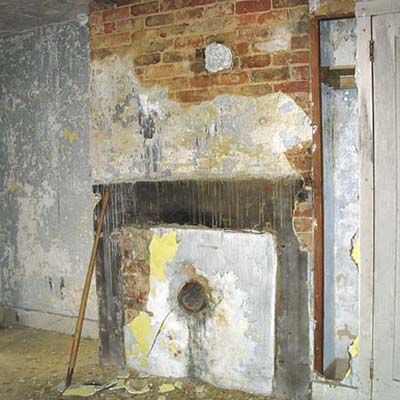
The bedroom’s original wood fireplace had been converted to a coal stove and was mostly walled up.
After: Mantel Makeover
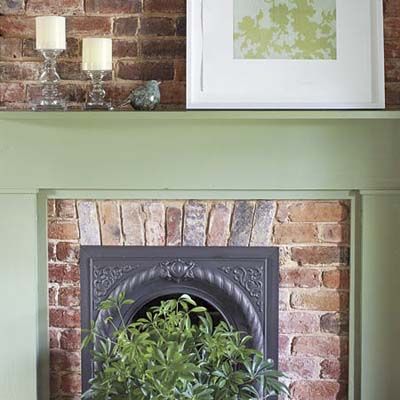
The newly refurbished but nonworking fireplace is the room’s new focal point. The fresh green paint on the bedroom’s original wood mantel brings out the russet tones of the old brick surround.
After: Powering Up the Kitchen
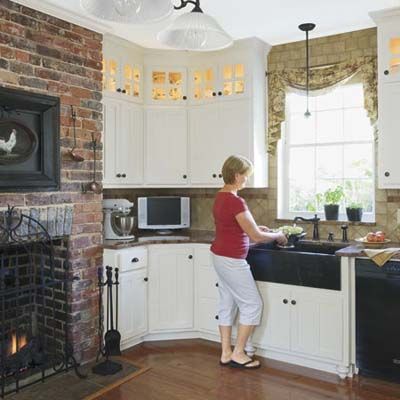
The house had only rudimentary plumbing and no electricity when we took it on. And to ensure that no one ever separated the two houses in the future, the city said we needed to run gas, plumbing, and other utility lines from the main house to the cottage we’d decided to make our new home. And it was up to Walt, ever the perfectionist, to figure out the best way to run the lines—not to mention how to bring power to the place.
By then, at least, the shell finally looked like it could withstand a stiff wind. When we first really inspected the place, I had trouble believing the brick masons who said it wouldn’t fall down. I mean, you could see daylight through the brickwork. Apparently, it just needed repointing.
After: Custom Cabinets
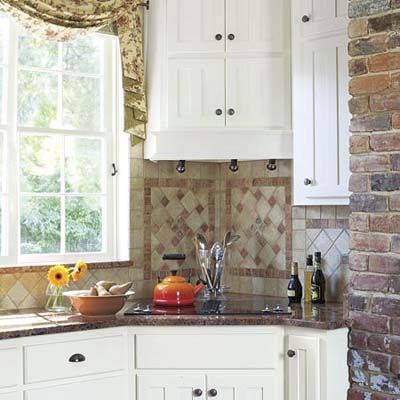
In the kitchen, we were originally going to go with stock cabinets and just use fillers to fit them into the awkward space. But a local appliance store referred us to great custom cabinetmakers who could make Shaker-style birch cabinetry—with undercabinet lights— to fit our vision. (They also built our bath vanity and two tall storage cabinets.)
For the windows, we contacted a well-known local craftsman. He made replacements for our four most damaged frames and sashes, but refused to do any more, saying we could repair the rest. So Walt carefully replaced damaged pieces until the 160-year-old windows worked like new.
Before: Kitchen
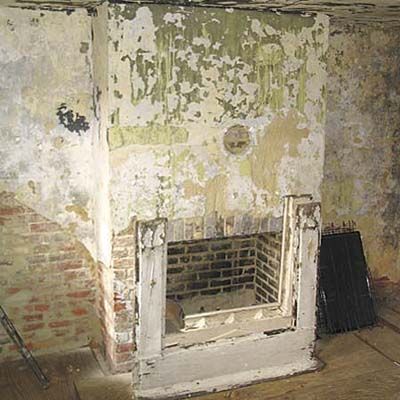
The original kitchen had no flooring, utilities, decent walls, or cabinetry. The windows were rotted, the fireplace was a disaster, and crumbling, water-damaged plaster covered much of the brick.
A Fine Mess
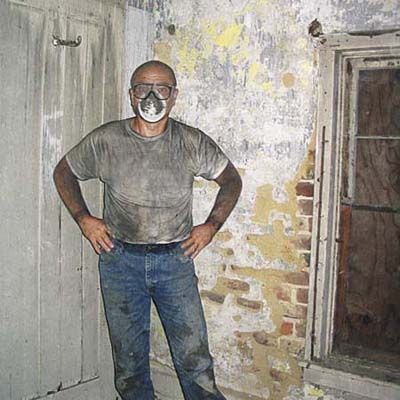
Walt shows off the right safety precautions during dirty demo work.
Street Side
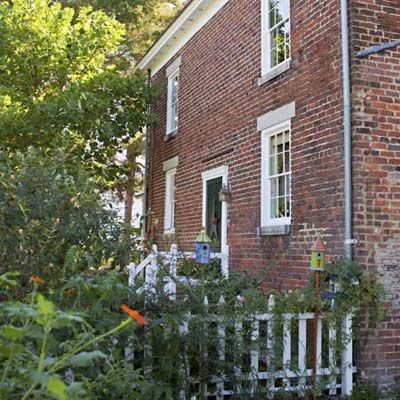
At one point, I asked Walt to build me a stoop so I could start landscaping around it. He thought it was a distraction from the more important interior work that remained, but I needed a project that would feed my soul. Not that it was easy. For years, people had been chucking bottles at the empty house, and the soil was riddled with glass. But with lots of digging and some new soil, I finally got my gardens growing.
We had also dug a 2-foot-deep trench right down to the house’s footings—in the Southern summer heat, mind you—for a gravel-filled French drain to prevent further water damage to the foundation. Working our way in, Walt spent a month redoing the rotted soffits and fascia boards.
Shown: The street-facing side of the house has a picket fence and a charming flower garden, complete with birdhouses.
For Appearances’ Sake
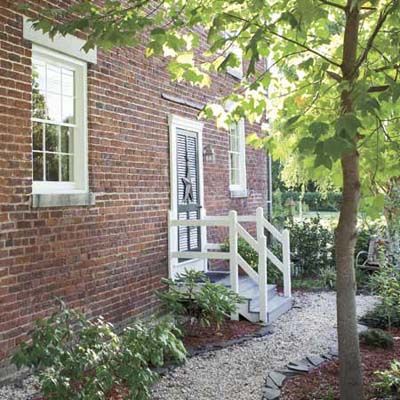
Wanting to be historically accurate, but not needing a third entry, we installed steps and a louvered door to create a faux entrance on the street side of the house.
After: Grand Master Bathroom
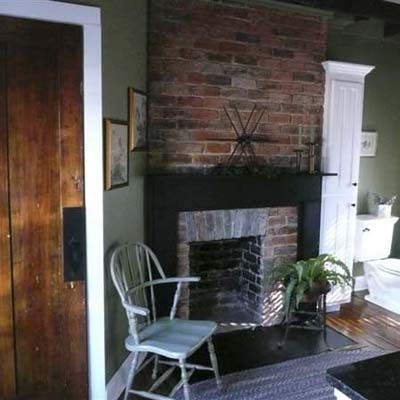
Since the house had just two rooms downstairs, and two rooms and the tiny ugly bathroom upstairs, we decided to eliminate the original bathroom and use one of the larger rooms as the new one. By bumping out the vanity wall, we were able to make space for the plumbing chase and a laundry closet. Walt repaired the fireplace and added a mantle. He also designed a closet and refinished an antique 2-panel door.
Refinishing Up
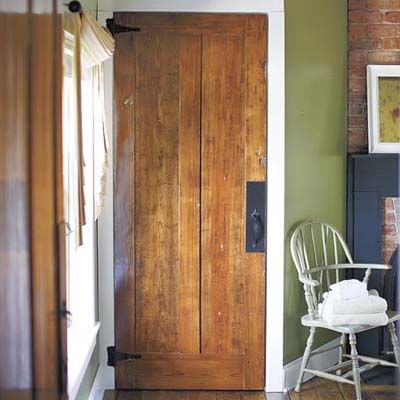
We stripped off six layers of paint to refinish this heart-pine door separating the bathroom and bedroom.
Before: Filthy Bathroom
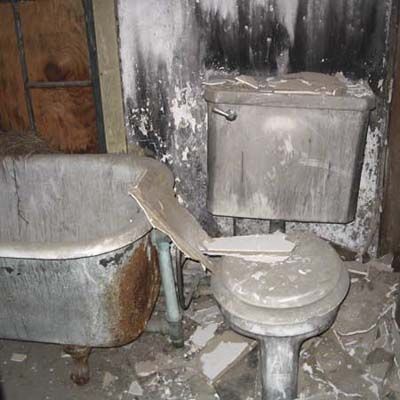
The original bathroom was small, dingy and, well, disgusting!
Ready to Be Repurposed
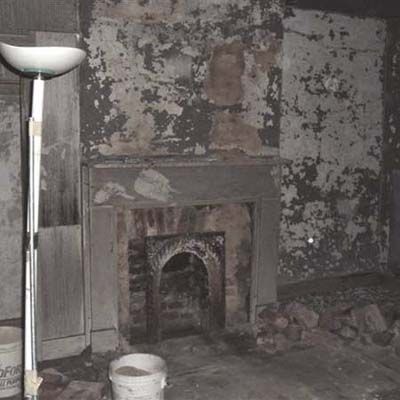
We saw potential in a larger upstairs room, which would make a much better bathroom in the small house.
After: Living Room Fireplace Facelift
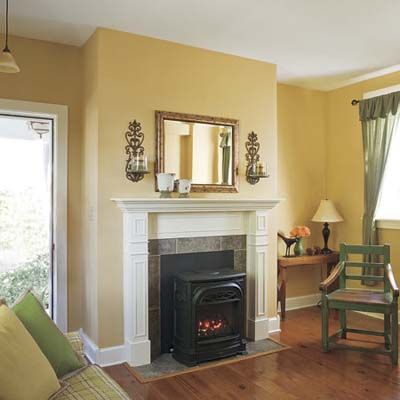
As winter came, we were doing a lot more work inside, though it wasn’t much better than being outdoors. With no insulation, no matter how much wood we burned it was still cold and damp. And we were constantly filthy. We had to nearly gut the house, filling a dumpster as long as the building with crumbled plaster and rotted wood. Thankfully, our two sons visited to get their hands dirty alongside us.
We took pride in learning new skills. The four wood-burning fireplaces had been bricked over for coal stoves. It would have cost us $700 per fireplace to hire a mason to undo that work, so Walt learned to do it himself—and used some of the money saved to buy himself a new bicycle.
Finishing Touches
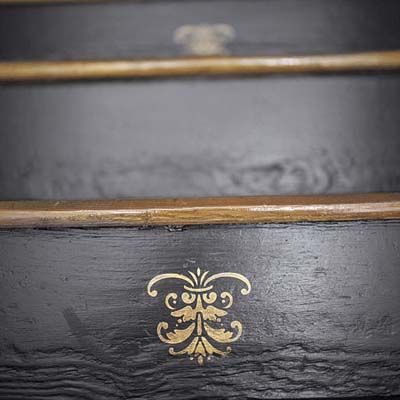
For over a year and a half, our life and conversations had revolved around the house, and it was almost sad to finish. But Petersburg is filled with people tackling similarly improbable projects, so we organized the Good Grief, What Were We Thinking Restoration and Rehabilitation Potluck Dinner. It was great fun to just sit around and talk with others about their rehab dreams and challenges.
Just a few small projects remain, like repaving the walkways and repointing some of the exterior walls. With more free time, we’re volunteering around the community, which has many historic homes like ours in need of some TLC. This house may not have been a typical retirement plan, but it turned out to be the perfect one for us.
Shown: The home’s partially rebuilt staircase got a new look with black paint and a gold stencil design.
What We Did
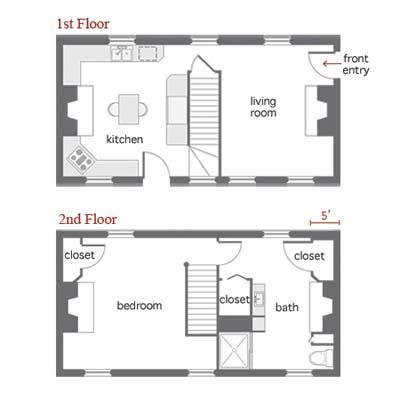
Rehabbed a 950-square-foot 1850s cottage. Remodeling cost: $65,000. Time frame: 18 months
Where We Saved: Repointing the brick fireplaces ourselves and salvaging what materials we could.
Where We Splurged: On the kitchen’s soapstone sink and custom cabinetry, but considering how much time we spend in there, it’s worth it.
What We Would Do Differently: Maybe invest in something a little more durable than pine floors. They’re all scratched up from our dog, but I guess you can call it character. (See Pet-Friendly Flooring)
Biggest Challenge: Running utilities, like plumbing, from the main house.
How We Solved It: By being patient and taking our time to plan it all out on paper before making any moves.
